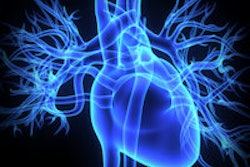
Despite some geographic variability, there are no major differences in the way nuclear myocardial perfusion imaging (MPI) studies are performed on men and women around the world, including the amount of radiation delivered, according to a new study published in JACC: Cardiovascular Imaging.
The global study of six regions found that while women in some countries accounted for fewer than 35% of patients undergoing MPI, there were no significant differences in treatment between the genders when societal and economic factors were considered.
In addition, the mean effective dose for nuclear cardiology procedures was only slightly lower in women than men, with a difference of 0.3 mSv when adjusting for age and weight differences between the genders (JACC Cardiovasc Imaging, April 2016, Vol. 9:4, pp. 376-384).
"Surprisingly to my colleagues and me, once a nuclear myocardial perfusion imaging study was performed, there were no big differences between men and women," said senior author Dr. Andrew Einstein, PhD, an associate professor of medicine in radiology at Columbia University Medical Center. "We expected to find more in the way of gender differences in terms of utilization of best practices and radiation dose."
4th in a series
The paper is the fourth report from the IAEA Nuclear Cardiology Protocols Cross-Sectional Study (INCAPS) and provides information on a grander scale than what has previously been available.
 Dr. Andrew Einstein, PhD, from Columbia University Medical Center.
Dr. Andrew Einstein, PhD, from Columbia University Medical Center."Radiation dose has been a big issue over the past several years, but there hasn't been any good data on the differences between genders in terms of radiation doses and use of best practices in nuclear cardiology," Einstein told AuntMinnie.com.
The researchers surveyed 7,911 MPI studies performed at 308 nuclear cardiology laboratories in 65 countries during one week in March or April 2013. The largest number of subjects came from Europe (2,381 patients, 30%), followed by North America (2,135, 27%), Asia (1,469, 18%), Latin America (1,139, 15%), Australia and New Zealand (439, 6%), and Africa (348, 4%).
Men accounted for the majority of the cohort (59%), with female representation ranging from 38% to 45% of all patients undergoing MPI, depending on the geographic region. On average, women were generally older (mean age, 65.1 ± 12 years) than men (mean age, 63.5 ± 12 years) and weighed less.
The researchers noted the patients' gender, age, and body weight, as well as the scanner and MPI protocol used. Protocol details included the modality (SPECT or PET), whether the exam was a one- or two-day study, imaging positions, the use of attenuation correction (CT or radionuclide), and the type and dose of radiopharmaceutical administered.
Einstein and colleagues also used the Gender Inequality Index (GII) and the Human Development Index (HDI) to stratify socioeconomic differences worldwide. GII is a composite index designed to reflect gender inequalities in reproductive health, empowerment, and economic status, while HDI is intended to measure human development conditions such as life expectancy, education, and standard of living.
Gender comparisons
In the global comparison of nuclear cardiology studies, women received a lower effective dose (mean effective dose, 9.6 ± 4.5 mSv) than men (10.3 ± 4.5 mSv) (p < 0.0001).
Even when adjusting for the overall lighter weight and older age of female subjects, women still received 0.3 mSv less effective dose than men (p < 0.001).
"That's not to say there are no significant geographic variabilities from laboratory to laboratory, but there was no important difference or minimal difference in best practices, which is a good thing," Einstein said.
| Regional comparison of mean effective radiation dose | ||
| Location | Women | Men |
| Europe | 7.3 ± 3.5 mSv | 8.3 ± 3.4 mSv |
| Africa | 9 ± 5.5 mSv | 10.2 ± 5.5 mSv |
| Australia/New Zealand | 9.1 ± 3.8 mSv | 9.4 ± 3.6 mSv |
| North America | 10.3 ± 4.5 mSv | 10.6 ± 4.6 mSv |
| Asia | 10.9 ± 4.8 mSv | 11.8 ± 4.8 mSv |
| Latin America | 11.4 ± 4.3 mSv | 12 ± 4 mSv |
There remain some areas where best practices can be improved, he noted, but even where deficiencies are evident, the researchers did not find a big difference between men and women.
"For example, the frequency of stress-only imaging in women was 12.5%, and 8.4% in men, which I think is lower than what should be the case," he said. "Still, we expected to find more in the way of gender differences in terms of utilization of best practices and radiation dose."
The greatest difference between the genders was found in Europe, where stress-only imaging was administered to 23% of women who underwent MPI, compared with 14% of men (p < 0.001).
Also, dual-isotope imaging was used less frequently in women (1%) than men (1.5%) (p < 0.001). Women received a mean effective dose ranging from 3.4 mSv for PET to 21.6 mSv for dual-isotope procedures. For men, the mean effective dose ranged from 4 mSv for PET to 20.5 mSv for dual-isotope procedures.
There was "no statistically significant difference in the use of PET in women compared with men across the world, likely at least in part because of limited access to PET scanners on the global market," the authors wrote.
Global perspective
So, what does it all mean?
It's uncertain whether the lower radiation observed is due to intentional efforts to reduce radiation dose to women, or whether it's linked to regional differences in imaging resources, access to radiopharmaceuticals, or use of radionuclide imaging based on gender-related clinical protocols, the authors wrote.
"In some countries, such as China and India, less than 25% of nuclear stress tests were performed in women, and that probably reflects some gender bias in referral patterns," Einstein said.
All in all, however, the findings "suggest, reassuringly, that there does not seem to be a large gender bias in radiation exposure from MPI globally," the researchers concluded.




















